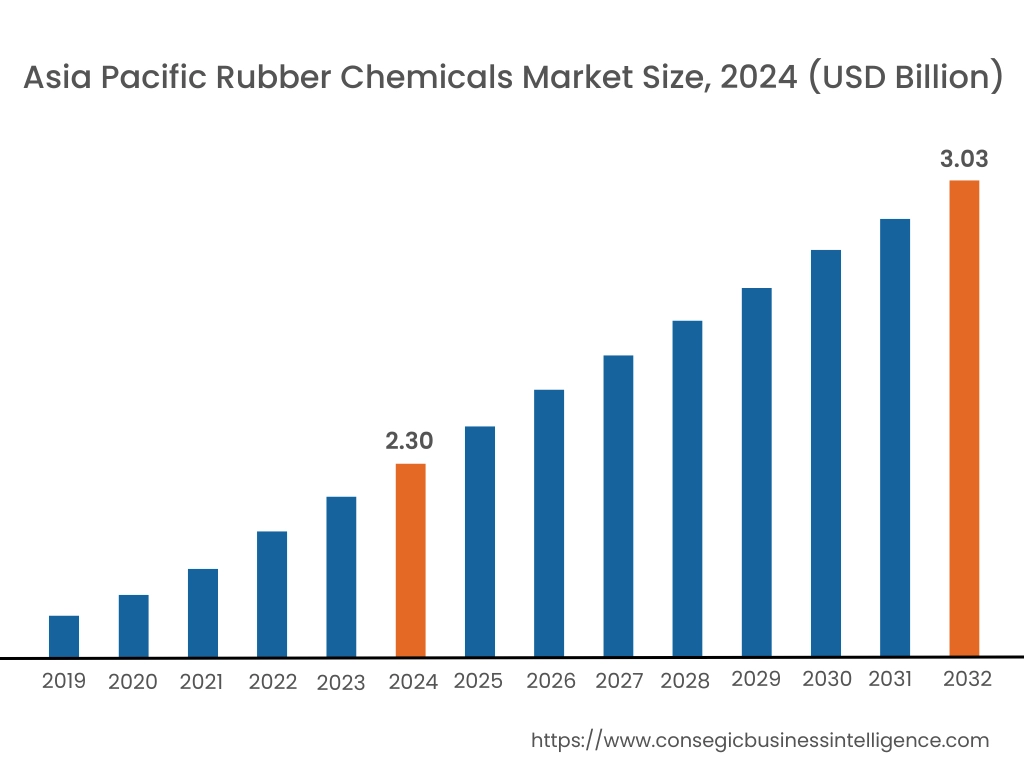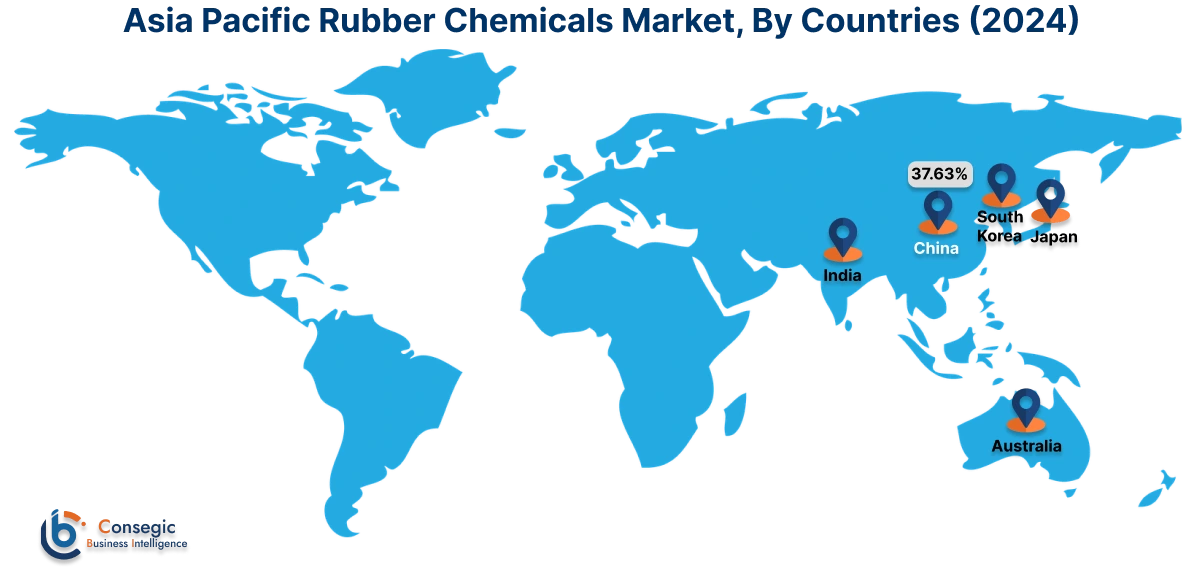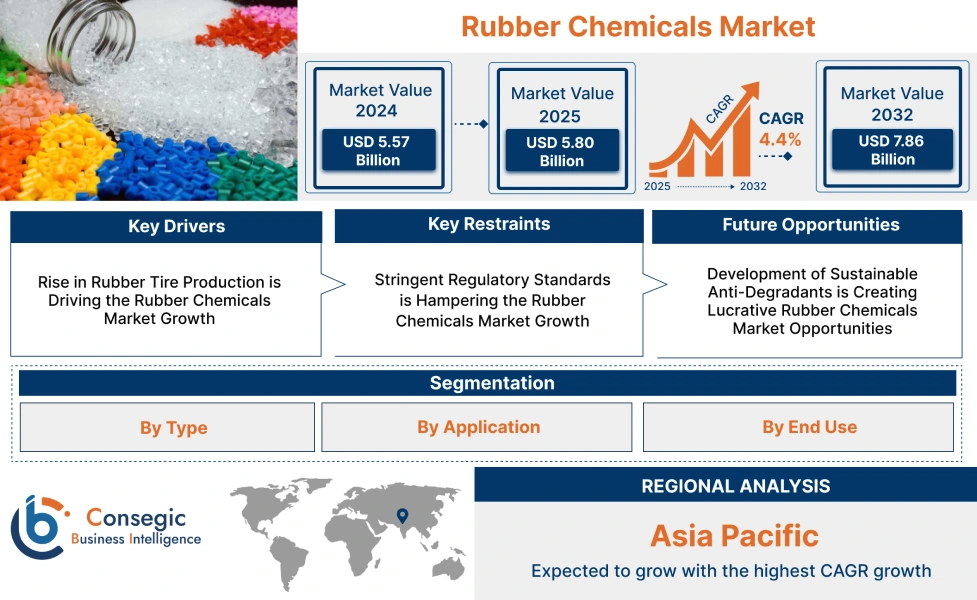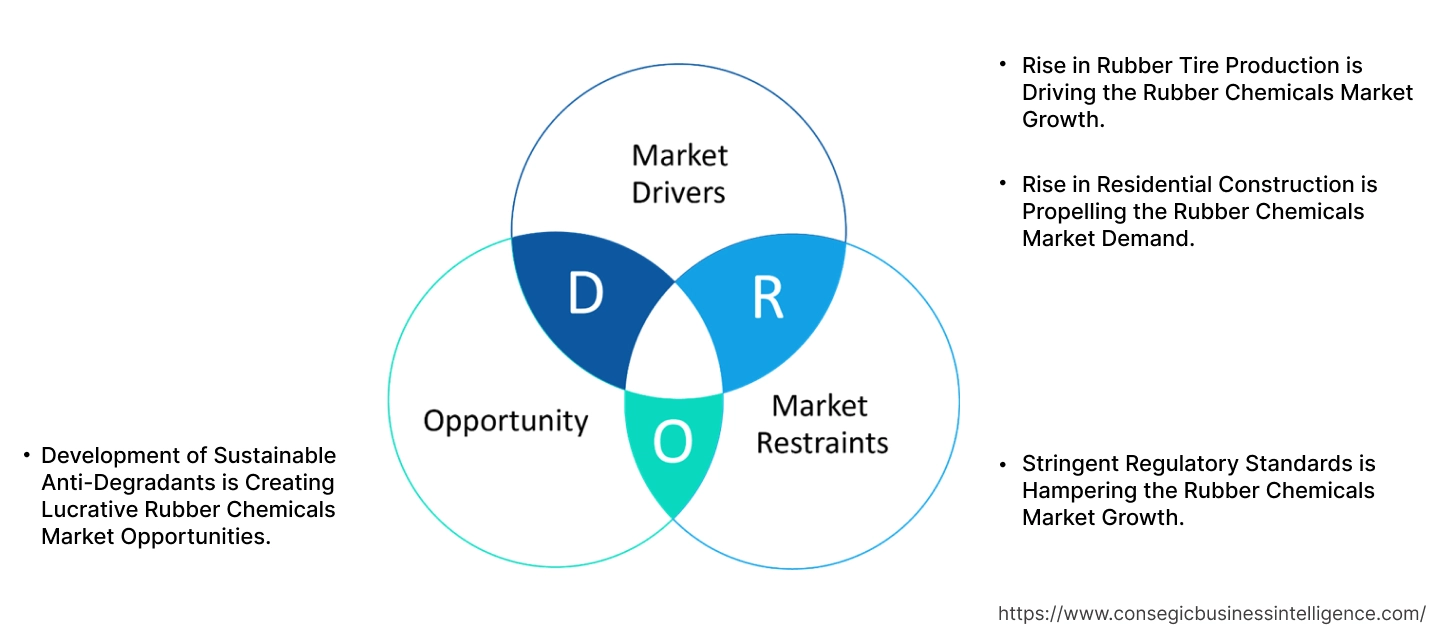Rubber Chemicals Market Size:
Rubber Chemicals Market size is growing with a CAGR of 4.4% during the forecast period (2025-2032), and the market is projected to be valued at USD 7.86 Billion by 2032 from USD 5.57 Billion in 2024. Additionally, the market value for the 2025 attributes to USD 5.80 Billion.
Rubber Chemicals Market Scope & Overview:
Rubber chemicals are a group of organic and inorganic substances essential in the production and processing of natural and synthetic rubber. These chemicals are incorporated into rubber compounds to enhance their processability, improve their physical and mechanical properties, and extend their service life. They play critical roles in various stages, from the initial mixing and shaping of the rubber to the final vulcanization (curing) process that imparts elasticity and strength. The chemical types include anti-degradants that protect rubber from environmental degradation, accelerators that speed up the crucial vulcanization process, processing aids that aid in processing and material homogeneity, vulcanizing agents responsible for crosslinking and elasticity, and others. These chemicals find their application in tires, rubber conveyor belts, footwear, rubber adhesives, medical tubes, and others. The end use consists of automotive, construction, healthcare, consumer goods, and others.
How is AI Impacting the Rubber Chemicals Market?
AI is optimizing the rubber chemicals market by enhancing efficiency and quality control across the entire value chain. In research and development, AI algorithms analyze vast datasets to predict optimal formulations for new compounds, significantly reducing the time and cost of physical experiments. In manufacturing, it enables predictive maintenance by monitoring machinery to forecast potential failures, minimizing unplanned downtime. AI-powered vision systems also perform real-time quality control, detecting defects in products with high precision, which reduces waste and improves product consistency. This technology is making the industry more sustainable and responsive to demand.
Key Drivers:
Rise in Rubber Tire Production is Driving the Rubber Chemicals Market Growth.
Rubber tire production is a complex process that involves the mixing of natural and synthetic rubbers such as acrylic rubber, and chloroprene rubber with various chemicals and reinforcing materials. Chemicals such as antioxidants, antiozonants, accelerators, vulcanizing agents, plasticizers, and processing aids are crucial at different stages. These chemicals enhance the tire's strength, durability, elasticity, and processability, ultimately ensuring the performance and safety of the final product. The growing use of rubber tires in various automotive is influencing the rise in the production of tires.
For instance,
- China's rubber tire production saw a significant 9.5% increase year-on-year in December 2024, reaching 105.56 million units.
Thus, the growing production of rubber tires and the use of chemicals is influencing the rubber chemicals market demand.
Rise in Residential Construction is Propelling the Rubber Chemicals Market Demand.
Increased building activities necessitate the use of various rubber-based materials like sealants, adhesives, roofing membranes, flooring underlays, and even rubber components in plumbing and insulation. These applications require specific rubber chemicals to ensure durability, flexibility, weather resistance, and structural integrity. The rise in residential construction and the use of chemicals for various applications is influencing the use of these chemicals.
For instance,
- According to the data from the S. Census Bureau and the U.S. Department of Housing and Urban Development, approximately 1.31 million new housing units were started and 1.61 million were completed in 2024.
Thus, the rise in the residential sector influences the rubber chemicals market expansion.
Key Restraints:
Stringent Regulatory Standards is Hampering the Rubber Chemicals Market Growth.
The rubber chemicals industry faces significant hurdles due to stringent regulatory standards imposed by various regulatory bodies worldwide. These regulations, mainly focused on environmental protection and human health, restrict or ban the use of certain chemicals deemed hazardous. Compliance with these evolving and increasingly strict rules, such as REACH in Europe and similar regulations globally, necessitates substantial investments in research and development for safer alternatives, modifications to production processes, and extensive documentation.
Additionally, changes in regulatory guidelines or the introduction of stricter regulations disrupt established processes and require significant investments in research, development, and manufacturing to meet the new standards. These factors contribute to increased costs, delayed product launches, and limited market access, ultimately hindering the development of the rubber chemicals industry.
Future Opportunities :
Development of Sustainable Anti-Degradants is Creating Lucrative Rubber Chemicals Market Opportunities.
The development of sustainable anti-degradants for rubber tires presents significant potential driven by increasing environmental concerns and regulatory pressures. The development of bio-based, recyclable, or less toxic alternatives addresses these issues, offering tire manufacturers a competitive edge by appealing to environmentally conscious consumers and meeting stricter regulations. Manufacturers are working on introducing bio-based chemicals that are specifically designed for tires.
For instance,
- In 2025, LANXESS introduced Vulkanox HS Scopeblue, a sustainable TMQ antioxidant with over 55% bio-based and ISCC PLUS certified since 2024 in Germany. This anti-degradant helps tire makers create longer-lasting, greener tires and accelerate their sustainability targets.
Thus, the development of sustainable anti-degradants is creating lucrative rubber chemicals market opportunities.
Rubber Chemicals Market Segmental Analysis :
By Type:
Based on the Type, the market is categorized into anti-degradants, accelerators, processing aids, vulcanizing agents, and others.
Trends in the Type:
- The stringent environmental regulations and consumer demand lead to a strong trend towards developing and adopting bio-based, recyclable, and less toxic anti-degradants.
- The rising production and application of various synthetic rubbers in tires, automotive components, and industrial goods are significantly boosting the trends for efficient accelerators for their vulcanization.
The anti-degradants segment accounted for the largest market share in 2024.
- Anti-degradants are a crucial category of rubber chemicals designed to protect rubber compounds from deterioration caused by environmental factors such as oxidation, heat, and fatigue.
- These chemicals, including antioxidants and antiozonants, extend the service life and maintain the performance properties of rubber products, particularly tires and industrial components.
- These benefits offered by anti-degradants such as antioxidants, influence the rise in consumption for various applications.
- For instance, the data published by NCBI in 2022 states that the annual global consumption of rubber antioxidants exceeded 700,000 tons, representing approximately 40% of all rubber additives used.
- Thus, as per the market analysis, the rise in consumption of anti-degradants is influencing the rubber chemicals market trends.
The accelerator segment is expected to grow at the fastest CAGR over the forecast period.
- Accelerators are vital rubber chemicals that significantly speed up the vulcanization process, allowing it to occur at lower temperatures and with greater efficiency.
- These chemicals reduce the time needed for rubber to achieve its final elastic and strong state.
- They are classified as primary or secondary, with various types like thiazoles, sulfenamides, thiurams, and dithiocarbamates, each offering different cure rates and processing safety for diverse rubber applications, particularly in tire manufacturing and other rubber goods.
- Thus, as per the rubber chemicals market analysis, the rise in the use of accelerators for various rubber applications is driving segment growth in the coming years.
By Application:
Based on the application, the market is categorized into tires, rubber conveyor belts, footwear, rubber adhesives, medical tubes, and others.
Trends in application:
- The rise of EVs leads to a growing trend for specialized tires designed for their unique needs, focusing on lower rolling resistance for increased range, and patterns that enhance regenerative braking.
- The increasing preference for less invasive surgeries drives the need for thinner, more flexible, and durable tubing for catheters and endoscopes.
The tire segment accounted for the largest Rubber Chemicals market share in the year 2024.
- Rubber chemicals play a vital role in automotive tire manufacturing, transforming raw natural and synthetic rubbers into durable, high-performance products.
- These chemicals are incorporated during the compounding stage to enhance various properties.
- Accelerators speed up the vulcanization process, where sulfur crosslinks the rubber molecules to provide strength and elasticity.
- Antioxidants and antiozonants protect the tires from degradation caused by heat, oxygen, and ozone, extending their lifespan. The rise in the production of tires is influencing the use of these chemicals.
- For instance, The data published in JATMA states that the total production of rubber tires for automobiles in Japan increase from 863,000 in 2020 and 1,015,000 in 2021.
- Thus, the rise in the utilization of these chemicals in tires is driving the rubber chemicals market trends.
The medical tubes segment is expected to grow at the fastest CAGR over the forecast period.
- Rubber chemicals play a vital role in the production of medical tubes, ensuring they meet stringent healthcare requirements.
- Antioxidants and stabilizers enhance durability and prevent degradation from sterilization processes and bodily fluids.
- Plasticizers provide flexibility and strain resistance, crucial for patient comfort and effective fluid delivery. Vulcanizing agents ensure the necessary elasticity and strength.
- Thus, as per the rubber chemicals market analysis, the use of these chemicals in medical tubes is driving the segment demand in the coming years.
By End Use:
Based on end use, the market is categorized into automotive, construction, healthcare, consumer goods, and others.
Trends in End Use:
- There is a growing trend for advanced rubber chemicals that enhance tire performance and the longevity of other automotive rubber parts.
- Demand for specialized rubber formulations for specific medical applications, such as minimally invasive surgical tools is influencing the use of these chemicals.
The automotive segment accounted for the largest Rubber Chemicals market share of 37.55% in the year 2024.
- The automotive industry is the major consumer of rubber chemicals. These chemicals are essential in the production of a wide array of automotive components, with tires being the most significant application.
- Chemicals such as accelerators, antioxidants and antiozonants, fillers, processing aids, and vulcanizing agents among others are used in the development of various rubber components used in automobiles.
- The rise in automotive production is directly having an impact on the utilization of these chemicals.
- For instance, the data provided by TD Economics states that North American automotive production surged in 2023, reaching 15.6 million vehicles, a 9.6% increase compared to 2022.
- Thus, as per the market analysis, the rise in the production of automotive is influencing the rubber chemicals market expansion.
The healthcare segment is expected to grow at the fastest CAGR over the forecast period.
- The healthcare sector utilizes rubber chemicals mainly to produce medical devices, protective equipment, and others. These chemicals are essential in manufacturing gloves, catheters, seals, and others because of their flexibility, durability, and resistance to chemicals.
- These chemicals also enhance the performance and longevity of these products, ensuring safety and hygiene in the medical environment.
- Antioxidants and stabilizers ensure the durability and integrity of these products during sterilization and use, while plasticizers provide the necessary flexibility. Antimicrobial agents are increasingly incorporated to prevent infections.
- Thus, as per the market analysis, the rise in the use of these chemicals in healthcare products is driving the market growth in the coming years.

Regional Analysis:
The regional segment includes North America, Europe, Asia Pacific, the Middle East and Africa, and Latin America.

In 2024, Asia Pacific accounted for the highest market share at 41.23% and was valued at USD 2.30 Billion and is expected to reach USD 3.03 Billion in 2032. In Asia Pacific region, China accounted for the highest market share of 37.63% during the base year of 2024. Automotive tire production in the Asia Pacific region is a massive sector, with China leading as a global production hub. This vast output necessitates a significant consumption of various rubber chemicals. Accelerators are crucial for the efficient vulcanization of both natural and synthetic rubbers, which form the bulk of tire materials. Antioxidants and antiozonants are vital to combat the region's diverse climatic conditions, preventing premature degradation of tires. The rise in the requirement of premium tires for Electric Vehicles is influencing the growth of new tires.
For instance,
- In 2023, ZC Rubber entered the Chinese EV passenger car tire market with its new EV PRO lineup, marking a significant expansion of its premium product range and commitment to the electric vehicle sector.
Thus, the rise in the use of these chemicals for tires is influencing the market growth in this region.

Europe is experiencing the fastest growth with a CAGR of 5.8% over the forecast period. Europe is driving the adoption of sustainable rubber chemicals, heavily influenced by stringent REACH regulations and the European Green Deal. This regulatory landscape pushes manufacturers to innovate and utilize bio-based alternatives, such as lignin-based antioxidants, and develop cleaner processing aids. Tire manufacturers are increasingly seeking sustainable anti-degradants to meet green tire targets. Thus, the focus is on reducing the environmental footprint of rubber production and ensuring compliance with evolving standards that are fostering a market for innovative and sustainable chemical solutions.
In North America's construction sector, rubber chemicals enhance the performance and durability of various materials. Sealants and adhesives rely on them for flexibility and strong bonding. Roofing membranes and waterproofing materials gain weather resistance and longevity. Rubber additives also improve the properties of concrete and coatings. With a growing emphasis on sustainable building practices, there's increasing interest in eco-friendly rubber chemical alternatives for construction applications in the region. Thus, as per the market analysis, the rise in the use of these chemicals for construction applications is influencing the use of these chemicals.
The use of rubber chemicals in healthcare in the Middle East and Africa (MEA) region is crucial for producing essential medical devices and consumables. These chemicals ensure the safety, functionality, and durability of products like medical gloves, tubing for fluid transfer, seals for medical containers, and components in various medical devices. Growing healthcare infrastructure, rising healthcare expenditure, and increasing awareness of infection control are driving the requirement for high-quality medical rubber products in the MEA region. Thus, as per the market analysis, the rise in the use of these chemicals for construction applications is impacting the market trends.
The use of rubber chemicals in consumer goods within the Latin America region is driven by a growing requirement for durable and versatile products. These chemicals enhance the properties of rubber in footwear for better wear resistance, in household items for flexibility and longevity, and in sporting goods like boxing equipment, and others for performance and safety. As the region's middle class expands and consumer spending increases, the need for quality rubber-based goods rises, consequently boosting the consumption of associated rubber chemicals that enable their production and improve their characteristics. Thus, as per the market analysis, the rise in the requirement for consumer products is driving the market demand in this region.
Top Key Players and Market Share Insights:
The global Rubber Chemicals market is highly competitive with major players providing precise products to the national and international markets. Key players are adopting several strategies in research and development (R&D) and product innovation to hold a strong position in the global Rubber Chemicals market. Key players in the Rubber Chemicals industry include-
- Nocil Ltd (India)
- Sovereign Chemical Company (United States)
- Nanjing Union Rubber and Chemicals Co., Ltd (China)
- Finochem (India)
- LANXESS (Germany)
- Lions Industries (Hong Kong)
- BEST(TIANJIN) NEW MATERIAL TECHNOLOGY CO., LTD (China)
- OUCHI SHINKO CHEMICAL INDUSTRIAL CO., LTD. (Japan)
Rubber Chemicals Market Report Insights :
| Report Attributes | Report Details |
| Study Timeline | 2019-2032 |
| Market Size in 2032 | USD 7.86 Billion |
| CAGR (2025-2032) | 4.4% |
| By Type |
|
| By Application |
|
| By End Use |
|
| By Region |
|
| Key Players |
|
| North America | U.S. Canada Mexico |
| Europe | U.K. Germany France Spain Italy Russia Benelux Rest of Europe |
| APAC | China South Korea Japan India Australia ASEAN Rest of Asia-Pacific |
| Middle East and Africa | GCC Turkey South Africa Rest of MEA |
| LATAM | Brazil Argentina Chile Rest of LATAM |
| Report Coverage |
|
Key Questions Answered in the Report
How big is the Rubber Chemicals market? +
In 2024, the Rubber Chemicals market is USD 5.57 Billion.
Which is the fastest-growing region in the Rubber Chemicals market? +
Europe is the fastest-growing region in the Rubber Chemicals market.
What specific segmentation details are covered in the Rubber Chemicals market? +
Type, Application, and End Use segmentation details are covered in the Rubber Chemicals market.
Who are the major players in the Rubber Chemicals market? +
Nocil Ltd (India), Sovereign Chemical Company (United States), and LANXESS (Germany) are some of the major players in the market.


